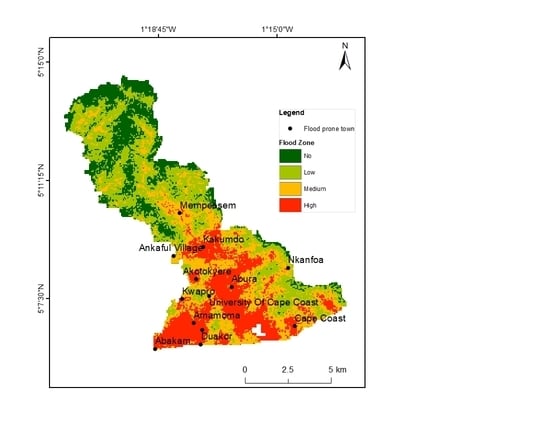Application of an Index-Based Approach in Geospatial Techniques for the Mapping of Flood Hazard Areas: A Case of Cape Coast Metropolis in Ghana
Abstract
1. Introduction
2. Materials and Methods
2.1. Study Area
2.2. Data Sources and Processing
Setting up Data for Use in ArcGIS
2.3. Information Extraction
2.3.1. Digital Elevation Model (DEM)
2.3.2. ISRIC World Soil Information
2.3.3. Landsat 8 Imagery
2.4. Flood Hazard Mapping
2.4.1. Factors Included in the Flood Hazard Index (FHI)
2.4.2. Computing Flood Hazard Index (FHI)
- FHI—Flood Hazard Index;
- ri—The ranking assigned to a factor;
- n—The number of factors;
- E—Elevation;
- S—Slope;
- FA—Flow Accumulation;
- SD—Stream Density;
- DS—Distance from Streams;
- NDVI—Normalized Difference Vegetation Index;
- SDC—Soil Drainage Capacity;
- LULC—Land Use/Land Cover.
3. Results
3.1. Flood Causal Factors
3.1.1. Digital Elevation Model
3.1.2. Slope
3.1.3. Flow Accumulation
3.1.4. Stream Density
3.1.5. Distance from Streams
3.1.6. Soil Drainage Capacity
3.1.7. Normalized Difference Vegetation Index (NDVI)
3.1.8. Land Use/Land Cover (LULC) Classification
3.2. Flood Hazard Mapping
3.2.1. Flood Hazard Zones
3.2.2. Flood Hazard Index Validation
4. Discussion
4.1. Policy Recommendations
- The Cape Coast Metropolitan Assembly (CCMA) should fund the dredging of rivers and streams as shown in Figure 7 every two years because the periodic dredging of river networks could salvage the situation. This would require huge financial allocation from the local assembly but would go a long way to reduce flood cases in the Metropolis.
- Considering the role of vegetation in reducing runoff, it will be prudent on the part of city authorities to plant trees along riverbanks to serve as a buffer. This should be done with the total participation of the local folks since their involvement would prove crucial in ensuring success.
- NADMO, CCMA, and Ghana Police should work in tandem to ensure strict compliance with buffer zone policies. Authorities must enforce such laws devoid of political interference or favor to deter residents from building close to riverbanks as shown in Figure 6.
- The Assembly should make the necessary effort to construct concrete banks to prevent sediments from filling the river channel.
- Residents within the CCM especially those living in flood hazard zones should take education and early warning communication by disaster management organizations seriously to minimize the effects of floods should they occur.
- Moreover, residents in CCM should construct houses with recourse to building codes since many communities lay within high flood hazard zones.
4.2. Limitations of the Study
5. Conclusions
Author Contributions
Funding
Acknowledgments
Conflicts of Interest
References
- Khalil, R. Flood Risk Code Mapping Using Multi Criteria Assessment. J. Geogr. Inf. Syst. 2018, 10, 686–698. [Google Scholar] [CrossRef]
- Moazzam, M.F.U.; Vansarochana, A.; Rahman, A.U. Analysis of flood susceptibility and zonation for risk management using frequency ratio model in District Charsadda, Pakistan. Int. J. Environ. Geoinform. 2018, 5, 140–153. [Google Scholar] [CrossRef]
- Tairi, A.; Elmouden, A.; Aboulouafa, M. Modelling Floods Risk Using GIS in Agadir Morocco. Am. J. Eng. Res. 2018, 7, 34–44. [Google Scholar]
- Addo, I.Y.; Danso, S.Y. Sociocultural factors and perceptions associated with voluntary and permanent relocation of flood victims: A case study of Sekondi-Takoradi Metropolis in Ghana. Jàmbá 2017, 9. [Google Scholar] [CrossRef]
- Opolot, E. Application of Remote Sensing and Geographical Information Systems in Flood Management: A Review. Res. J. Appl. Sci. Eng. Technol. 2013, 6, 1884–1894. [Google Scholar] [CrossRef]
- Amoako, E.O.; Lin, S. Application of Remote Sensing Technique and Geographic Information Science for Flood Risk Mapping-A Case Study of the Offinso District, Kumasi-Ghana. J. Remote Sens. GIS 2018, 7. [Google Scholar] [CrossRef]
- Baishya, S.J.; Sahariah, D. Application of Remote Sensing and GIS for Flood Hazard Mapping: A Case Study at Baralia-Nona River Basin, Assam, India. Int. J. Humanit. Soc. Sci. Invent. 2017, 5, 58–70. [Google Scholar]
- Forkuo, E.K. Flood Hazard Mapping using Aster Image data with GIS. Int. J. Geomat. Geosci. 2011, 1, 932–950. [Google Scholar]
- Sanyal, J.; Lu, X.X. Application of Remote Sensing in Flood Management with Special Reference to Monsoon Asia: A Review. Nat. Hazards 2004, 33, 283–301. [Google Scholar] [CrossRef]
- Albano, R.; Sole, A. Geospatial methods and tools for the management and communication of natural risk. ISPRS Int. J. Geo-Inf. 2018, 7, 470. [Google Scholar] [CrossRef]
- Asare-Kyei, D.; Forkuor, G.; Venus, V. Modeling Flood Hazard Zones at the Sub-District Level with the Rational Model Integrated with GIS and Remote Sensing Approaches. Water 2015, 7, 3531–3564. [Google Scholar] [CrossRef]
- Brivio, P.A.; Colombo, R.; Maggi, M.; Tomasoni, R. Integration of remote sensing data and GIS for accurate mapping of flooded areas. Int. J. Remote Sens. 2002, 23, 429–441. [Google Scholar] [CrossRef]
- Aja, D.; Elias, E.; Obiahu, O.H. Flood risk zone mapping using rational model in a highly weathered Nitisols of Abakaliki Local Government Area, South-eastern Nigeria. Geol. Ecol. Landsc. 2019, 4, 131–139. [Google Scholar] [CrossRef]
- Danumah, J.H.; Odai, S.N.; Saley, B.M.; Szarzynski, J.; Thiel, M.; Kwaku, A.; Kouame, F.K.; Akpa, L.Y. Flood risk assessment and mapping in Abidjan district using multi-criteria analysis (AHP) model and geoinformation techniques, (Cote d’Ivoire). Geoenviron. Disasters 2016, 3, 10. [Google Scholar] [CrossRef]
- Elkhrachy, I. Flash Flood Hazard Mapping Using Satellite Images and GIS Tools: A case study of Najran City, Kingdom of Saudi Arabia (KSA). Egypt. J. Remote Sens. Space Sci. 2015, 18, 261–278. [Google Scholar] [CrossRef]
- European Commission. Sendai Framework for Disaster Risk Reduction 2015–2030. Available online: https://ec.europa.eu/echo/partnerships/relations/european-and-international-cooperation/sendai-framework-disaster-risk-reduction_en (accessed on 21 July 2020).
- United Nations Office for Disaster Risk Reduction (UNISDR). Sendai Framework for Disaster Risk Reduction 2015–2030. Available online: www.unisdr.org (accessed on 16 May 2019).
- United Nations Office for Disaster Risk Reduction (ISDR) and the World Bank Disaster Risk Management Programs for Priority Countries. Available online: https://www.gfdrr.org/node/814 (accessed on 16 May 2019).
- Almoradie, A.; Brito, M.M.; Evers, M.; Bossa, A.; Lumor, M.; Norman, C.; Yacouba, Y.; Hounkpe, J. Current flood risk management practices in Ghana: Gaps and opportunities for improving resilience. J. Flood Risk Manag. 2020. [Google Scholar] [CrossRef]
- The New Humanitarian West. Africa Flood Round-Up; News of 17 September 2013. Available online: https://www.thenewhumanitarian.org/news/2013/09/17/west-africa-flood-round (accessed on 23 July 2020).
- Tarhule, A. Damaging Rainfall and Flooding: The Other Sahel Hazards. Clim. Chang. 2005, 72, 355–377. [Google Scholar] [CrossRef]
- Samela, C.; Manfreda, S.; De Paola, F.; Giugni, M.; Sole, A.; Fiorentino, M. DEM-based approaches for the delineation of flood-prone areas in an ungauged basin in Africa. J. Hydrol Eng. 2016, 21, 2. [Google Scholar] [CrossRef]
- Nyarko, B.K. Application of a Rational Model in GIS for Flood Risk Assessment in Accra, Ghana. J. Spat. Hydro. 2002, 2, 14. [Google Scholar]
- Asumadu-Sarkodie, S.; Owusu, P.A.; Jayaweera, H.M.P.C. Flood risk management in Ghana: A case study in Accra. Adv. Appl. Sci. Res. 2015, 6, 196–201. [Google Scholar]
- Asumadu-Sarkodie, S.; Owusu, P.A.; Rufangura, P. Impact analysis of flood in Accra, Ghana. Adv. Appl. Sci. Res. 2015, 6, 53–78. [Google Scholar] [CrossRef]
- United Nations Office for the Co-Ordination of Humanitarian Affairs (OCHA). Ghana Floods. Available online: https://reliefweb.int/sites/reliefweb.int/files/resources/030E5488C9AB5C7FC1257758004B7535-Full_Report.pdf (accessed on 22 July 2020).
- International Federation of Red Cross and Red Crescent Societies (IFRC). Ghana/Upper East: Floods Emergency Plan of Action DREF Operation no MDRGH016. Available online: https://reliefweb.int/report/ghana/ghana-upper-east-floods-emergency-plan-action-dref-operation-n-mdrgh016 (accessed on 19 July 2020).
- Annan-Prah, A.; Amewowor, D.H.A.K.; Osei-Kofi, J.; Amoono, S.E.; Akorli, S.Y.; Saka, E.; Ndadi, H.A. Street foods: Handling, hygiene and client expectations in a World Heritage Site Town, Cape Coast, Ghana. Afr. J. Microbiol. Res. 2011, 5. [Google Scholar] [CrossRef]
- Fox, E. Floods Leave Many Dead in Southern Ghana. Available online: https://www.aljazeera.com/news/2016/06/floods-leave-dead-southern-ghana-160616104330811.html (accessed on 23 July 2020).
- Frimpong, E.D.; UCC Suspends Lectures Following Campus Floods. Graphic Online. Available online: https://www.graphic.com.gh/news/general-news/ghana-news-ucc-suspends-lectures-following-campus-floods.html (accessed on 30 June 2020).
- Mensah, H.; Ahadzie, D.K. Causes, impacts and coping strategies of floods in Ghana: A systematic review. SN Appl. Sci. 2020, 2, 792. [Google Scholar] [CrossRef]
- Konadu, D.D.; Fosu, C. Digital Elevation Models and GIS for Watershed Modelling and Flood Prediction—A Case Study of Accra Ghana. In Appropriate Technologies for Environmental Protection in the Developing World; Yanful, E.K., Ed.; Springer: Dordrecht, The Netherlands, 2009; pp. 325–332. ISBN 978-1-4020-9138-4. [Google Scholar]
- Kwang, C.; Osei, M.E. Accra Flood Modelling through Application of Geographic Information Systems (GIS), Remote Sensing Techniques and Analytical Hierarchy Process. J. Remote Sens. Gis 2017, 6. [Google Scholar] [CrossRef]
- Ministry of Food and Agriculture (MOFA). Cape Coast Metropolitan. Available online: http://mofa.gov.gh/site/directorates/district-directorates/central-region/206-cape-coast-metropolitan (accessed on 30 June 2020).
- Ghana Districts. Cape Coast Metropolitan Assembly. Available online: http://ghanadistricts.com/Home/District/67 (accessed on 30 June 2019).
- Ghana Statistical Service. 2010 Population and Housing Census. Summary Report of Final Results. Available online: https://www.statsghana.gov.gh/gssmain/storage/img/marqueeupdater/Census2010_Summary_report_of_final_results.pdf (accessed on 23 July 2020).
- Kendie, S.B. Employment Structure and the Environment in Cape Coast, Ghana. Singap. J. Trop. Geogr. 1998, 19, 26–38. [Google Scholar] [CrossRef]
- Senevirathne, N.; Willgoose, G. A comparison of the performance of DEM pit filling algorithms for hydrology. In Proceedings of the 20th International Congress on Modeling and Simulation, Adelaide, Australia, 1–6 December 2013. [Google Scholar]
- Prodanovic, D.; Stanic, M.; Milivojevic, V.; Simic, Z.; Arsic, M. DEM-based algorithms for automatic creation of hydrological models data. J. Serb. Soc. Comput. Mech. 2009, 3, 64–85. [Google Scholar]
- Kazakis, N.; Kougias, I.; Patsialis, T. Assessment of flood hazard areas at a regional scale using an index-based approach and Analytical Hierarchy Process: Application in Rhodope–Evros region, Greece. Sci. Total Environ. 2015, 538, 555–563. [Google Scholar] [CrossRef]
- Osman, A.; Nyarko, B.K.; Mariwah, S. Vulnerability and risk levels of communities within Ankobra estuary of Ghana. Int. J. Disaster Risk Reduct. 2016, 19, 133–144. [Google Scholar] [CrossRef]
- Harris Geospatial. Calculate Confusion Matrices. Available online: https://www.l3harrisgeospatial.com/docs/CalculatingConfusionMatrices.html (accessed on 14 November 2020).
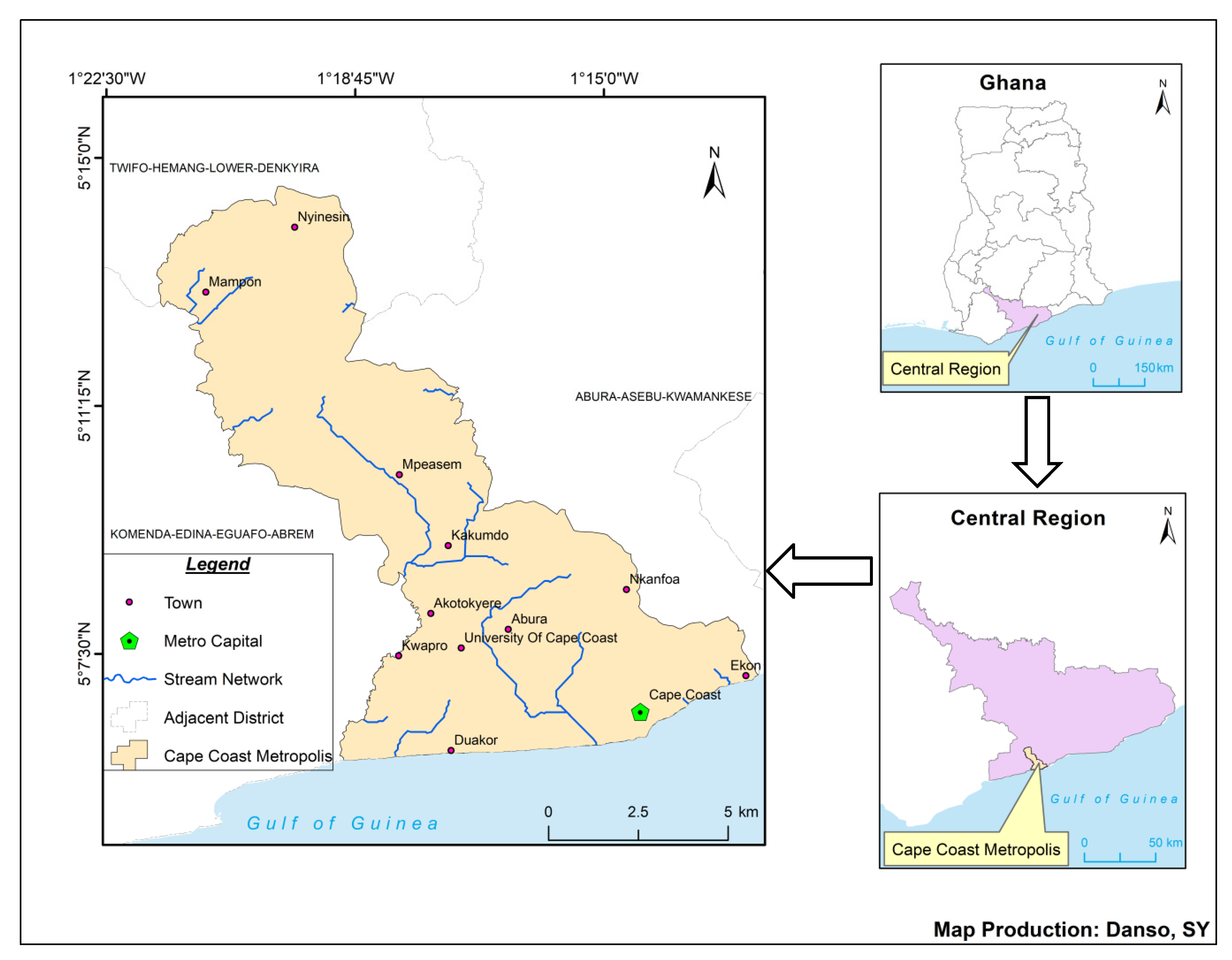
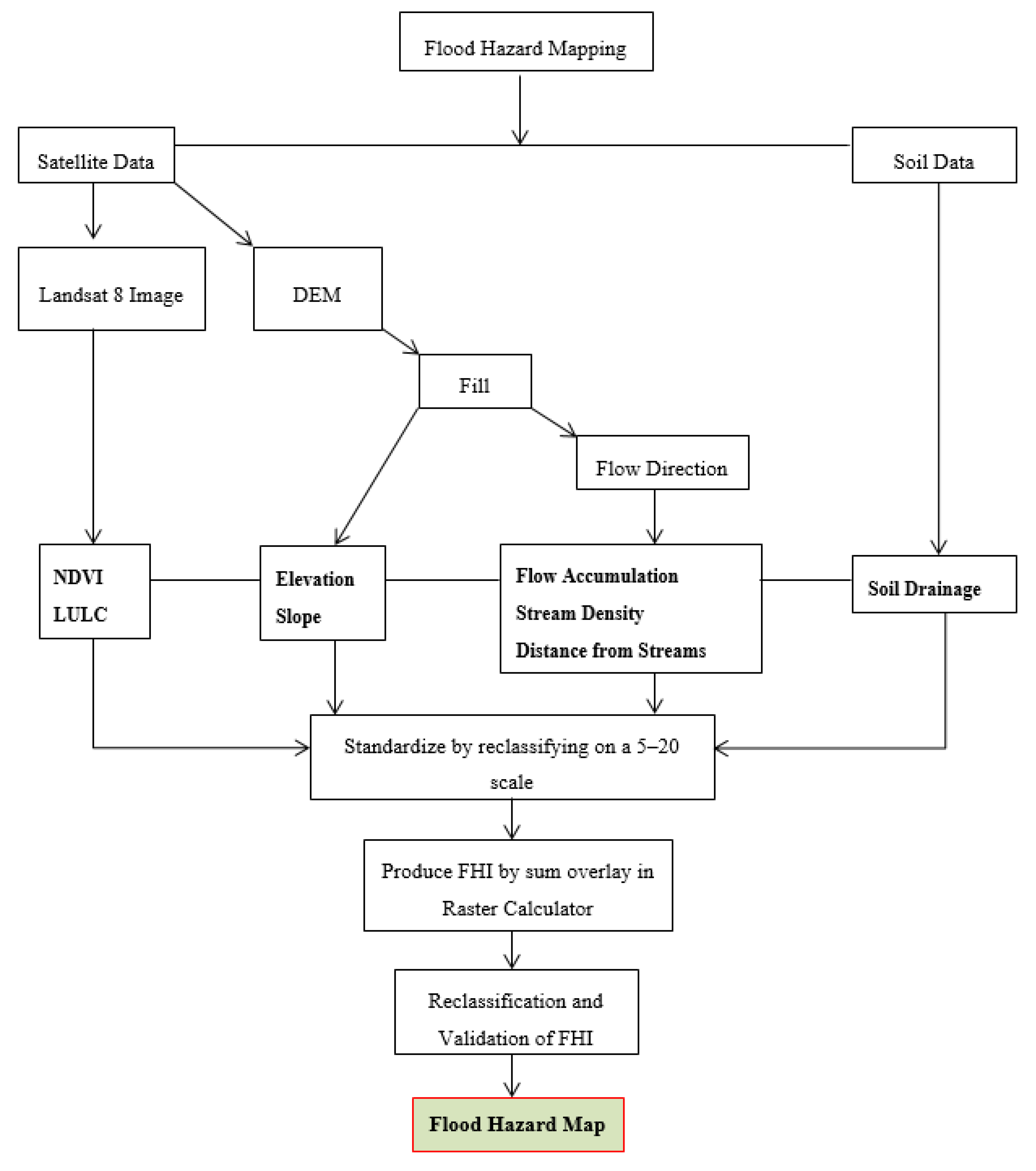
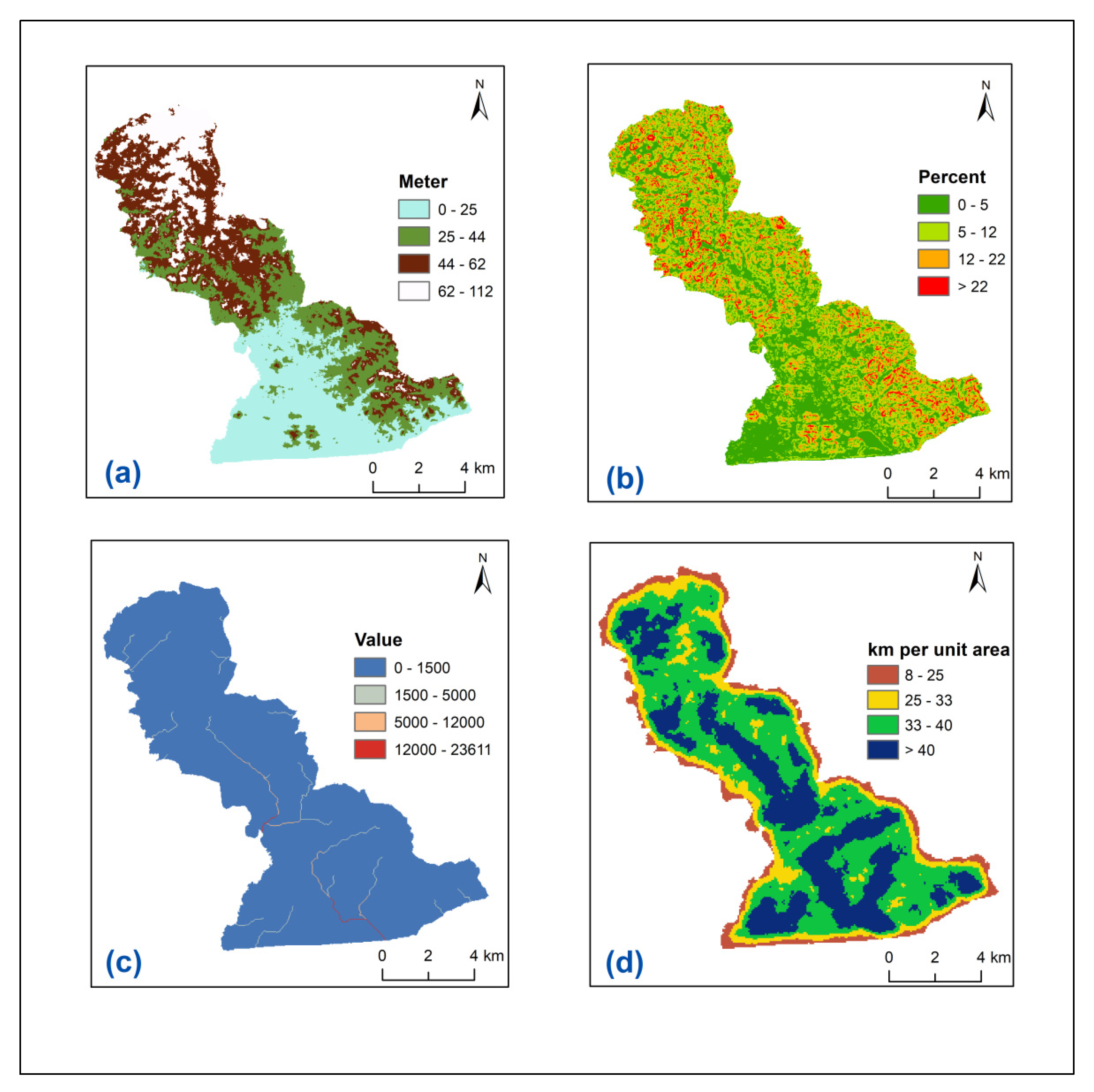
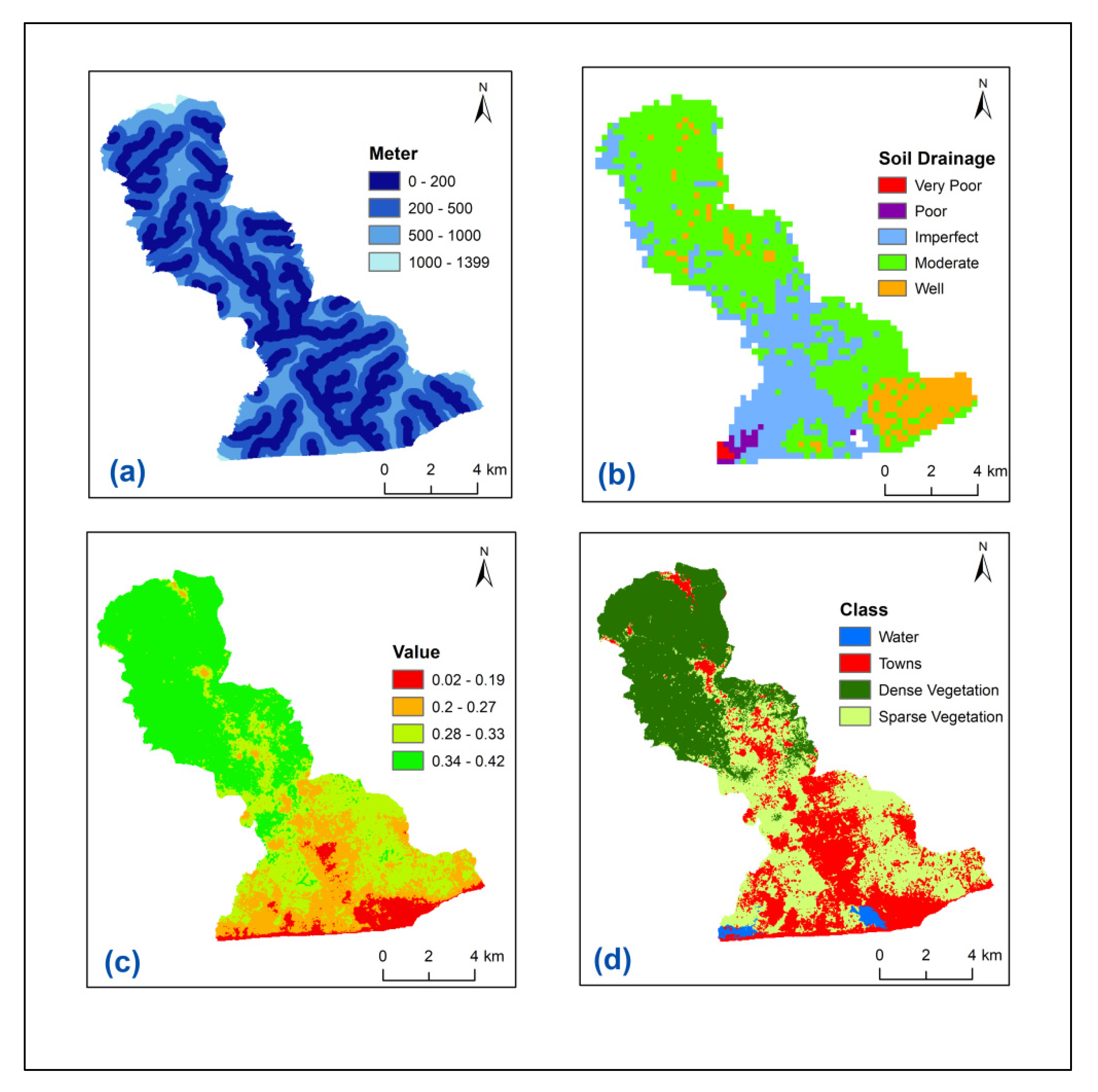
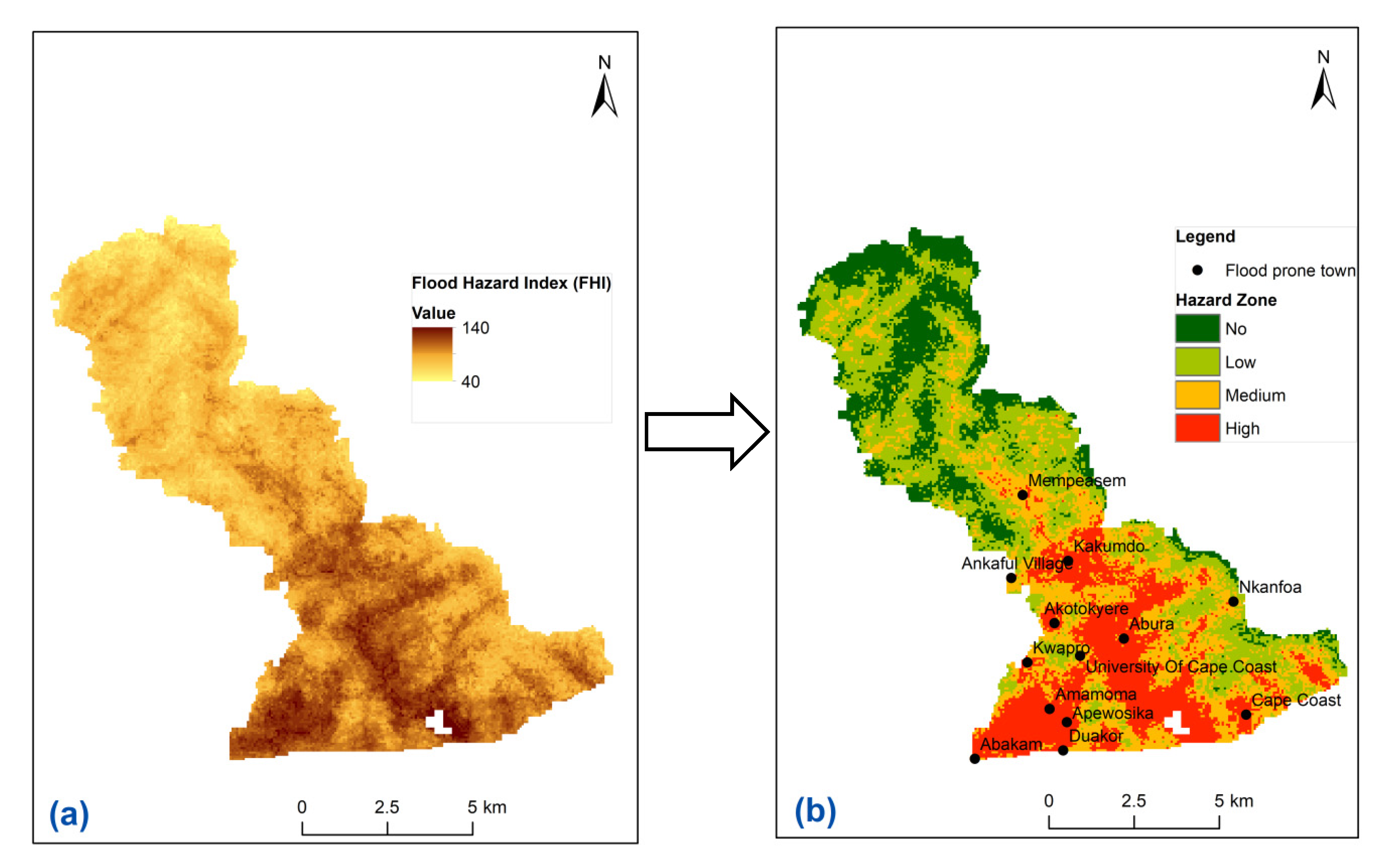
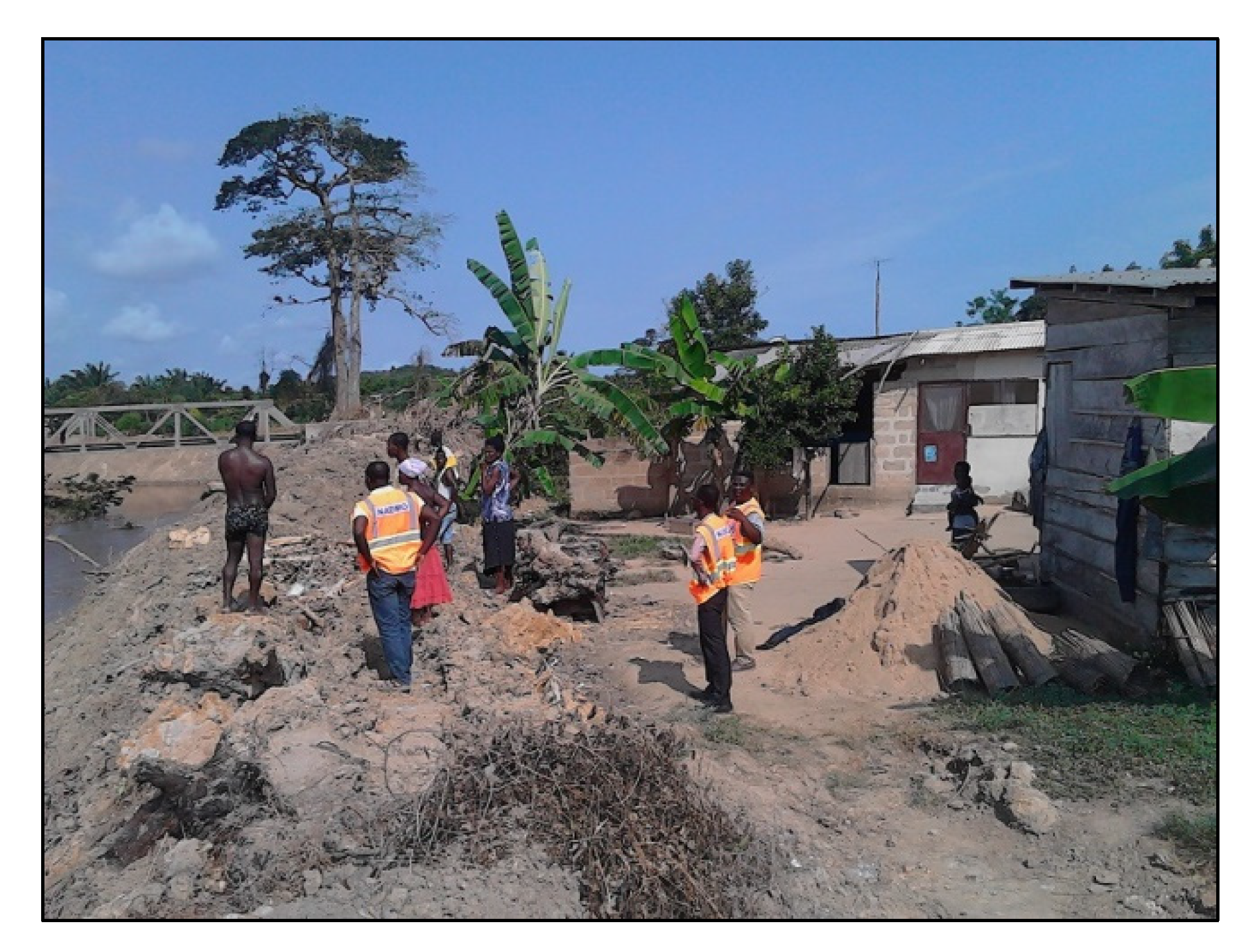
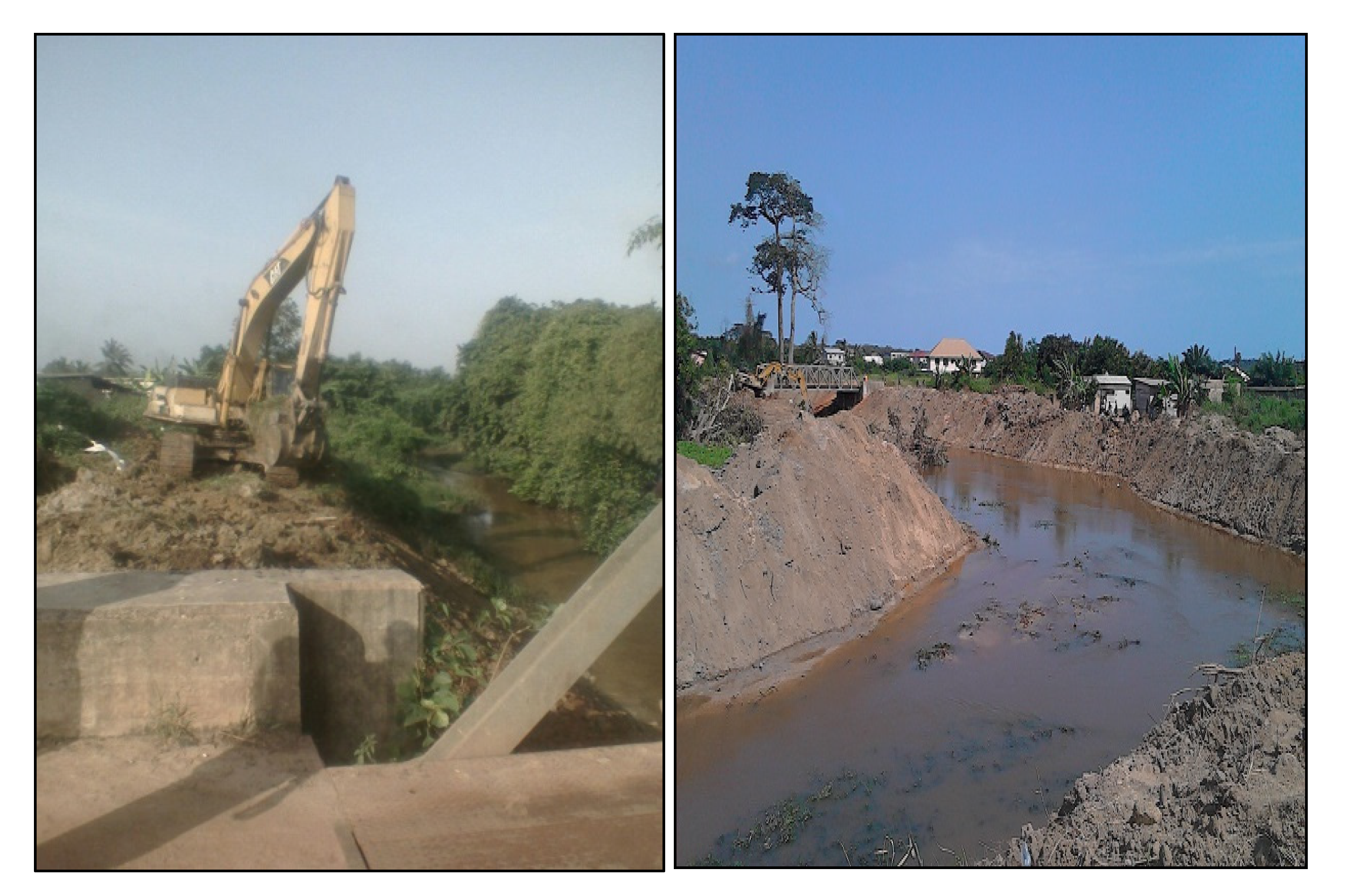
| Factor | Classes | Rank for Factor |
|---|---|---|
| Elevation | 0–25 | 20 |
| 25–44 | 15 | |
| 44–62 | 10 | |
| 62–112 | 5 | |
| Slope (%) | 0–5 | 20 |
| 5–12 | 15 | |
| 12–22 | 10 | |
| >22 | 5 | |
| Flow Accumulation | >12,000 | 20 |
| 5000–12,000 | 15 | |
| 1500–5000 | 10 | |
| <1500 | 5 | |
| Stream Density | >40 | 20 |
| 33–40 | 15 | |
| 25–33 | 10 | |
| 8–25 | 5 | |
| Distance from Streams (Meters) | 0–200 | 20 |
| 200–500 | 15 | |
| 500–1000 | 10 | |
| >1000 | 5 | |
| Normalized Difference Vegetation Index (NDVI) | 0.024–0.186 | 20 |
| 0.186–0.265 | 15 | |
| 0.265–0.332 | 10 | |
| 0.332–0.423 | 5 | |
| Soil Drainage Capacity | Very Poor | 20 |
| Poor | 15 | |
| Imperfect | 10 | |
| Moderate/Well | 5 | |
| Land Use/Land Cover (LULC) | Urban | 20 |
| Water | 15 | |
| Sparse Vegetation | 10 | |
| Dense Vegetation | 5 |
| Class | Water | Town | Dense Vegetation | Sparse Vegetation | Row Total | User’s Accuracy |
|---|---|---|---|---|---|---|
| Water | 23 | 1 | 0 | 3 | 27 | 85.18% |
| Town | 0 | 154 | 1 | 26 | 181 | 85.08% |
| Dense Vegetation | 0 | 8 | 322 | 15 | 345 | 93.33% |
| Sparse Vegetation | 3 | 20 | 21 | 204 | 248 | 82.25% |
| Column Total | 26 | 183 | 344 | 248 | 801 | |
| Producer’s Accuracy | 88.46% | 84.15% | 93.6% | 82.25% |
| No. | Flood-Prone Community | Population |
|---|---|---|
| 1. | Abakam/Duakor | 601 |
| 2. | Abura/Ayifoa | 18,829 |
| 3. | Adisadel Village | 10,824 |
| 4. | Amamoma | 1312 |
| 5. | Ankaful | 1956 |
| 6. | Antam | 10,824 |
| 7. | Apewosika | 1901 |
| 8. | Kakumdo | 3229 |
| 9. | Kwapro | 1810 |
| 10. | Mempeasem | 1066 |
| 11. | Nkanfoa | 3680 |
| 12. | North Ola/Ameen Sangari | 12,210 |
Publisher’s Note: MDPI stays neutral with regard to jurisdictional claims in published maps and institutional affiliations. |
© 2020 by the authors. Licensee MDPI, Basel, Switzerland. This article is an open access article distributed under the terms and conditions of the Creative Commons Attribution (CC BY) license (http://creativecommons.org/licenses/by/4.0/).
Share and Cite
Danso, S.Y.; Ma, Y.; Adjakloe, Y.D.A.; Addo, I.Y. Application of an Index-Based Approach in Geospatial Techniques for the Mapping of Flood Hazard Areas: A Case of Cape Coast Metropolis in Ghana. Water 2020, 12, 3483. https://doi.org/10.3390/w12123483
Danso SY, Ma Y, Adjakloe YDA, Addo IY. Application of an Index-Based Approach in Geospatial Techniques for the Mapping of Flood Hazard Areas: A Case of Cape Coast Metropolis in Ghana. Water. 2020; 12(12):3483. https://doi.org/10.3390/w12123483
Chicago/Turabian StyleDanso, Samuel Yaw, Yi Ma, Yvonne Dodzi Ami Adjakloe, and Isaac Yeboah Addo. 2020. "Application of an Index-Based Approach in Geospatial Techniques for the Mapping of Flood Hazard Areas: A Case of Cape Coast Metropolis in Ghana" Water 12, no. 12: 3483. https://doi.org/10.3390/w12123483
APA StyleDanso, S. Y., Ma, Y., Adjakloe, Y. D. A., & Addo, I. Y. (2020). Application of an Index-Based Approach in Geospatial Techniques for the Mapping of Flood Hazard Areas: A Case of Cape Coast Metropolis in Ghana. Water, 12(12), 3483. https://doi.org/10.3390/w12123483





